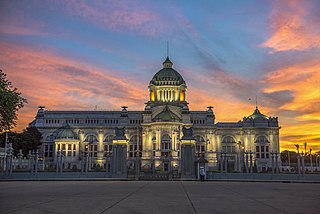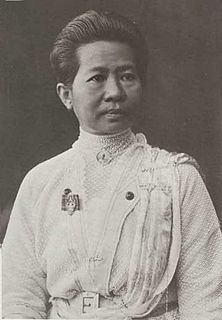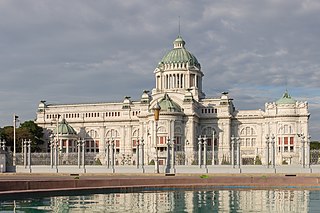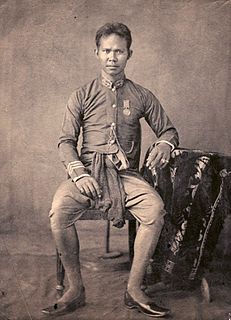
This is a list of royal residences in Bangkok.

This is a list of royal residences in Bangkok.

The Chakri dynasty is the current reigning dynasty of the Kingdom of Thailand, the head of the house is the king, who is head of state. The family has ruled Thailand since the founding of the Rattanakosin Era and the city of Bangkok in 1782; following the end of Taksin Thonburi's reign, when the capital of Siam shifted to Bangkok. The royal house was founded by Rama I, an Ayutthaya military leader of Sino-Mon descent.

Dusit District is one of the 50 districts (khet) of Bangkok, Thailand.

The Royal Plaza, or formally Dusit Palace Plaza, and also known among Thais as Equestrian Statue Plaza, is an important public square in the palace and government quarter of Bangkok, the capital of Thailand.

Sukhumala Marasri was a daughter of King Mongkut and his concubine, Samli (เจ้าคุณจอมมารดาสำลี). Her given name was Princess Sukhumala Marasri (พระองค์เจ้าสุขุมาลมารศรี). She was later one of the four consorts of her half-brother, King Chulalongkorn.

Queen Debsirindra of Siam, formerly Queen Ramphoei Phamaraphirom, born Princess Ramphoei Siriwong, was the second consort of King Mongkut, and mother of King Chulalongkorn.
The Palace Law of Succession, Buddhist Era 2467 (1924) governs succession to the Throne of the Kingdom of Thailand, under the ruling House of Chakri. Succession matters prior to the end of absolute monarchy in 1932 could be contentious, especially during the Ayutthaya period from the 14th to 18th centuries. In 1924, King Vajiravudh attempted to clarify the succession process by laying down the Palace Law of Succession. It was promulgated and came into effect in November 1924 as, in part, an attempt to eliminate the vagueness relating to succession within the Thai monarchical regime and to systematically resolve previous controversies. In 1932, after Siam became a constitutional monarchy, various amendments relating to succession were introduced. The 1997 Constitution of Thailand relied on the law with regards to succession, but the 2006 Interim Constitution made no mention of succession, leaving it to "constitutional practice." The 2007 Constitution again relied on the Palace Law. The preamble of the 2014 interim constitution of Thailand abrogated the 2007 Constitution, with the exception of chapter 2, concerning the monarchy and the succession.

Marshal-Admiral Paribatra Sukhumbandhu, Prince of Nakhon Sawan (1881–1944), was a highly influential Thai military officer and government minister in the early 20th century during the last years of the absolute monarchy. He served as Chief of Staff of the Royal Thai Army, Commander of the Royal Thai Navy, Naval Minister, Army Minister, Defense Minister, Interior Minister, and as a Privy Counsellor to both King Vajiravudh and King Prajadhipok.

The Ananta Samakhom Throne Hall is a royal reception hall in Dusit Palace in Bangkok, Thailand. It was commissioned by King Chulalongkorn in 1908. The building was completed in 1915, five years after Rama V's death in 1910. It is now employed from time to time for state occasions.

Krom Phra Ratchawang Bowon Sathan Mongkhon กรมพระราชวังบวรสถานมงคล, colloquially known as the Front Palace, was the title of the uparaja of Siam, variously translated as "viceroy", "vice king" or "Lord/Prince of the Front Palace", as the titleholder resided in the physical residence of the same name. The office of Front Palace was considered second only to the king and regarded as the heir presumptive. The name, with its dual meaning, originated in the Ayutthaya period, and the holder later gained significant powers during the Rattanakosin period. Front Palace occupants were usually a son or brother of the reigning monarch. The office existed until the death of the last occupant, Prince Vichaichan, in 1885. King Chulalongkorn then abolished the office of an heir presumptive, introducing in its stead the Western concept of a crown prince as heir apparent, and styled the new office "Crown Prince of Siam".

Princess Nibha Nobhadol, Princess of Uthong, or Somdet Phra Chao Boromwongse Ther Chao Fa Nibha Nobhadol Vimolprabhavadi Krom Khun Uthong Khetkhatiyanari, was the Princess of Siam. She was a member of Siamese Royal Family. She is a daughter of Chulalongkorn, King Rama V of Siam. She served as the personal secretary of her father, King Chulalongkorn, while he did many royal duties. He always wrote the letters while visiting Europe to her, which are all collected in her novel called Klai Baan or Far from home.

Somdet Phra Chao Lan Ther Chaofa Thong-In Krom Phra Rajawang Boworn Sathan Phimuk was a Siamese Prince and military leader. A nephew of King Phutthayotfa Chulalok the founder of the Chakri Dynasty, he was appointed Deputy Viceroy or Rear Palace, the 3rd highest position in the kingdom. Becoming the only person to hold that title during the Rattanakosin Kingdom.

Krom Phra Ratchawang Bowon Wichaichan or Phra Ong Chao Yodyingyot (พระองค์เจ้ายอดยิ่งยศ) was a Siamese Prince and member of the Chakri Dynasty. He was the eldest son of Viceroy Pinklao and Princess Aim, and thus nephew to King Mongkut. Wichaichan succeeded his father by being appointed the Front Palace and Viceroy of Siam in 1868, during the reign of his cousin King Chulalongkorn. During his tenure the office of Front Palace was extremely powerful and rivalled that of the monarch's own. Inevitably the two forces clashed in the Front Palace crisis. Wichaichan was defeated and the power of the Front Palace was greatly diminished. After his death in 1885, the last vestiges of the title were abolished in favour of a Crown Prince.
Karl Siegfried Döhring was a German architect, art historian and archaeologist. He lived mostly in Siam, now called Thailand.

Dusit Palace is a compound of royal residences in Bangkok, Thailand. Constructed over a large area north of Rattanakosin Island between 1897 and 1901 by King Chulalongkorn. The palace, originally called Wang Suan Dusit or 'Dusit Garden Palace' (วังสวนดุสิต), eventually became the primary place of residence of the King of Thailand, including King Chulalongkorn, King Vajiravudh, King Prajadhipok, King Bhumibol Adulyadej and King Vajiralongkorn. The palace covers an area of over 64,749 square metres (696,950 sq ft) and is dotted between gardens and lawns with 13 different royal residences. Dusit Palace is bordered by Ratchwithi Road in the north, Sri Ayutthaya Road in the south, Ratchasima Road in the west and U-Thong Nai Road on the east.

The Front Palace, officially the Phraratchawang Bowon Sathanmongkhon (พระราชวังบวรสถานมงคล), was the residence of the royal holder of the same title during the early-to-mid Rattanakosin Kingdom. The palace was built at the same time as the Grand Palace, following the accession of King Rama I and the foundation of Rattanakosin as the capital city in 1782. It was located at the northern end of the inner fortified city, directly in front of the Grand Palace, where the king lived, and provided security to the city.

The Amphorn Sathan Residential Hall or the Ambara Villa is a royal mansion situated inside Bangkok's Dusit Palace. It served as the primary residence of the former King Bhumibol Adulyadej and former Queen Sirikit of Thailand, and was the birthplace of King Vajiralongkorn.

The Phra Chuthathut Palace or Sichang Palace is a summer royal residence built during the reign of King Chulalongkorn the Great on the Sichang Island in Chonburi Province. After the French occupied the island during a conflict with Thailand over control of neighboring Laos in 1893, the royal residence was largely abandoned. Parts of the unfinished halls were removed and were used for the new Vimanmek Mansion in Bangkok. Since leaving the royal control, the palace has been used by various affiliations and authorities. Today, Chulalongkorn University occupies the palace for its "Sichang Marine Science Research and Training Station" and established the Chutathut Palace Museum of Chulalongkorn University, maintaining and preserving the palace.
Sukhothai Palace or Sukhodaya Palace is a royal residence situated on Samsen Road in Dusit District, Bangkok, Thailand. It is nearby to Dusit Palace and Vajira Hospital. The palace was the residence of King Prajadhipok and King Vajiralongkorn before they ascended to the throne. It has since become the official residence of Princess Bajrakitiyabha and Princess Sirivannavari Nariratana.

Rachini Road is a road in inner Bangkok, located in Phra Borom Maha Ratchawang Subdistrict of Phra Nakhon District.